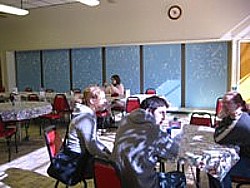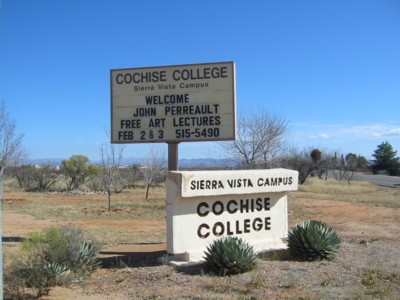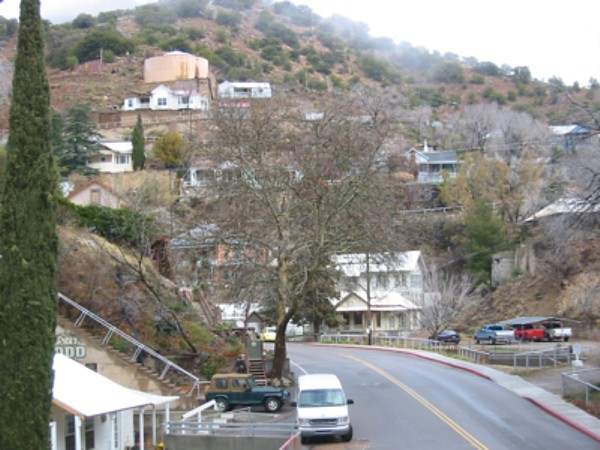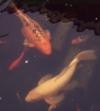
John Perreault, Toothpaste Mural II, 2005
“How to Innovate”
Lecture given at Cochise College, Sierra Vista, Arizona. February 2 and 3.
For better or worse, the art world puts a premium on innovation. Well, more or less. The history of modernism (and of its subset, postmodernism) is a history of innovations. Doing something new in the right way at the right time is rewarded, if not immediately, then sooner or later. We hope. Nowadays, unlike in the days of van Gogh or Gauguin or Picasso or even, more recently, Willem de Kooning, recognition tends to be quick. Why is this? Generations have been bred and fattened on the modernist legends, so no one wants to be embarrassed anymore by skipping over any new van Gogh; better to err on the side of too much acceptance too soon than on the side of ignorance.
Why innovation? Why the new? The modernist poet Ezra Pound once gave the advice to poets: make it new. He was in a new century, the 20th, and poetry like art had to be brought up to date. There was too much of a disconnect between art and everyday life.
But there are other reasons, in art at least, for making it new. That innovation in the past has been the sign of future greatness is the usual excuse, but the need for new products is a constant. The small pool of serious collectors, even though now global, needs to be tempted. Buying early is buying cheap, thus maximizing later profit. And although it now appears that the art market over the long run really doesn’t do as well as the stock market, buying winning stocks offers little visual pleasure and less visible prestige. Most people don’t hang their stock portfolios over the sofa.
Timing, of course, is crucial. I started by saying that innovation had to be done in the right way at the right time. The right way is a concept we cannot go into here, except to say that it probably has to do with breadth of product and product placement. But the right time is easy enough:
There were several others who spilled or splashed directly on the canvas before Pollock. André Masson was one, and even Miró did a splash or two. Janet Sobel was splashing around in the early ’40s. But Pollock, along with doing it big and over and over again so that he established a signature product, also did it at exactly the right moment: the art world and the media needed a hero. Not a woman; not a Spaniard or a Frenchman; but an American male. In music we had Charlie Parker, who was a black man — but he filled the bill. And more so. In acting, we had James Dean. It could have been Marlon Brando, but he just kept on living.
I think there is more to art than innovation. There is a spiritual core to art; nevertheless, its content needs to be communicated in an innovative way. The same old imagery will not wake us up. Then there is the matter of inspiration.
As a young man, in one of those life-changing happenstances, I (although born in the Village’s St. Vincent’s Hospital) found myself again in Manhattan, the center of all things bohemian. I was feeling frustrated about my poetry. Rimbaud had stopped writing poetry when he was 18. I was 23 and still not published, except for my college literary magazine. Every day I passed the New School on the way home from my job uptown at Brentano’s Bookstore. I thought: why don’t I see if there’s a poetry workshop? There was, and it was offered by the New York School poet Kenneth Koch, whom I had never heard of. It turned out he was a wonderful teacher, and after one semester I won the Dylan Thomas Award. And it was through this poetry connection that I actually became an art critic.
One of the things I learned from Koch was this: you can’t just sit around waiting for inspiration; it may never come. You can force it. And he gave us exercises that were really inspiration techniques: instead of verse, write prose poems; write a poem that is a list. Compose a fake dream. Restrict yourself: write a sestina, and so forth. He had learned all of this from the Surrealists I think, and from his artist friends. As in poetry, in art you can also force inspiration…
You can indeed sometimes start from inside, yielding to all kinds of weird pressures and dreams, but it is easier to start from outside as a way of getting in.
But before I reveal to you the secrets of innovation, there is one other thing you have to know. Too often we are burdened with what I call the communication or tin-can-telephone fallacy. Basically, this is the idea that the sender X has some information Y to be sent through W to Z. Which in art would go like this: you have something you want to communicate or to express, so you code it in a medium. The message you want to express is, let’s say, “Life is beautiful.” And since you are a painter, you decide to transmit this idea or feeling through paint on canvas that will be looked at by someone else. Meaning precedes the creation. But what we are doing is illustrating, not creating.
Try to think of art as a situation in which meaning follows creation. What the artist does is discover meaning after he or she creates; this is what Duchamp meant when he said the artist was a medium. But what about communication? That comes later; the communication or the transmission is a situation in which the receiver rediscovers or uncovers the meaning — or even better yet, a new meaning. The meaning is in the feedback.
So here are some ways, with examples, of how to innovate in art through forcing inspiration:
Use a new methodology or way of making. Dripping, screen-printing, gnawing, lathering: Pollock, Warhol.
Use a new material. How about chocolate (Antoni) or toothpaste (Perreault)?
Copy something: Gorky copying Miró and Picasso, Pop artists copying comic strips, Malcolm Morley copying calendars or Vermeer; Mike Bidlo copying everybody. Copy yourself.
Put together two or more things that have not been joined before: obviously painting and sculpture (Robert Rauschenberg), art and theater(Rauschenberg), sound and vision, autobiography and abstraction.
Find a source outside art, or at least outside orthodox art. Cubism looked to African Art; Surrealism looked to South Pacific Art and North West Indian Art; Duchamp looked to alchemy and to the writing techniques of Raymond Roussel. Jean Dubuffet looked to the art of the insane, which he then called Art Brut.
Make it old. When painting is dead, surprise people by going back to painting; when abstract art is in the winning position, make realist art (Chuck Close).
Subtract something from art: representation, form, color, meaning. Is there anything else we can subtract? Conceptual art tried to remove even the physical, leaving only language (visible and in some cases oral). Can we then subtract language?
Add something to art: politics, feminism, personal narrative, objects. When it seemed as if art was just going to be empty colorless grids, a certain group of artists added color and decoration (Joyce Kozloff, Miriam Shapiro, Robert Zakanitch).
Redefine art. Duchamp said he was creating nonretinal art. Related to this is the following: try to make something that looks as little like art as possible.
Innovate out of ignorance. You can make something new simply because you don’t know any better. Many Outsider Artists fall into this category. People such as Henry Darger don’t break the rules; they don’t even know the rules.
Break the rules, or create new rules.
But best of all, find a new way to innovate.

Paint It Red ( And Green and Blue and Yellow)
In Arizona last week, I also gave a lecture at the Tucson Museum of Art in conjunction with curator Julie Sasse’s “Paint on Metal” (through May 1), a survey of just that.
In an effort to put the exhibition in a more critical context, I tried to probe the reason for the recent, but now thankfully abandoned, taboo against polychrome sculpture.
Of course, I had to bring up Rosalind Krauss’ 1974 expose of Clement Greenberg’s sanding down of some of David Smith’s late, painted (or at least primed) sculptures. But I noted that, aside from the small issue of honoring authorship and the artist’s intentions, aesthetically old Clem was probably right.
But we have to go back further than Greenberg; demonizing him is just immortalizing him. And why should we do that? He was right about Pollock and David Smith, but wrong about a lot else. And because of the good advice he gave far too many painters, he should also be remembered as a talented artistic collaborator.
We need to go back to the Greeks.
Greek sculpture was painted, as was the art of other polytheistic empires. For that little-known Ancient Cultures Disney effect, just take a look at the painted terra-cotta entablature of the neo-Classical Philadelphia Museum of Art.
Could antipolytheism be the origin of the polychrome taboo?
I ventured to mention the story of The Watchers in the apocryphal The Book of Enoch the Prophet ( 200 B.C.E?).
InEnoch, rediscovered in Ethiopia in 1773, the sons of God, mentioned in Genesis, become the “sons of heaven” (i.e. angels) and are called The Watchers.
After submitting to The Watchers, the human womenfolk “brought forth giants, whose stature was each three hundred cubits. They devoured all which the labor of men produced, until it became impossible to feed them; when they turned themselves against men in order to devour them; and began to injure birds, beasts, reptiles and fishes, to eat their flesh one after another and to drink their blood.”
But here’s the important part:
Azazyel, the leader of The Watchers, “taught men to make swords, knives, shields, breastplates, the fabrication of mirrors [more correctly, made them see that which was behind them] and the workmanship of bracelets and ornaments, the use of paint, the beautifying of the eyebrows, the use of stones of every valuable and select kind, and all sorts of dyes, so that the world became altered.
Enoch, as a few may remember, never died and was so favored by You-Know-Who that he was taken up physically to heaven. Nevertheless, in spite of Enoch’s pleas, The Watchers are forever doomed. The use of paint, metallurgy and cosmetics is unforgivable. Things must look exactly as they are.

Tombstone Canyon Road, Bisbee
Coy Koi and the Golem
Then I juried an exhibition at the Central School Project in Bisbee, which has to be one of my favorite places: an old copper-mining town in the mountains, where (it’s rumored) ancient hippies still hole up in caves. The Central School Project is an abandoned school purchased by 20 or so artists for studio space and public programs.I gave a poetry reading there, unveiling my Stolen Rhymes poems and ended with my first totally improvised-on-the-spot jazz poem. Stayed overnight at the funky 1890Inn at Castle Rock, formerly a miners’ boarding house on Tombstone Canyon Road. “We are not normal” says their business card, but the breakfast is better than normal. The dining room surrounds a well-like pit that started out as a silver mine, then sprung a spring that became the Bisbee water supply, and now 30 feet below my cloth-covered table is home to those gigantic Japanese goldfish called koi, circling and circling in their mirrorlike prison.
Next day, a two-hour drive back to Tucson. Studio visits with both Jim Waid, a favorite painter of mine for many years. Through scraping layered surfaces he discovers “landscapes” that are internal/external. And Albert Kogel, a new favorite. Kogel’spaintings on carved sheets of wood are at the Davis Domingas Gallery in Tucson (154 E. 6th Street, to March 15).
Monday, I am off to Prague in search of the Golem. But also to write about the sculptorKaren LaMonte, who now works in the Czech Republic.

